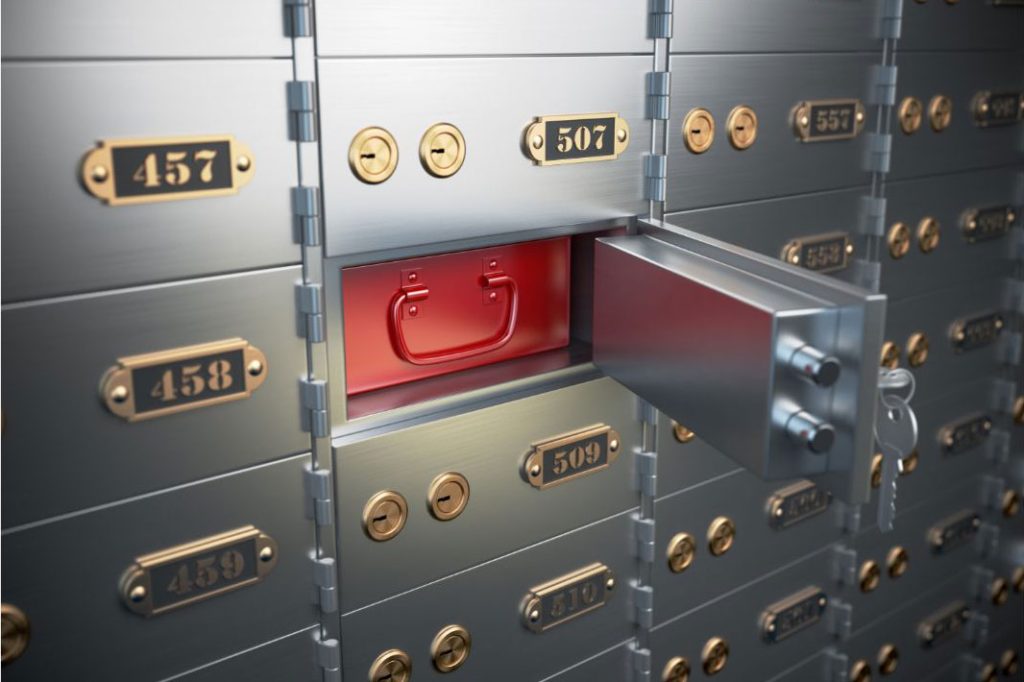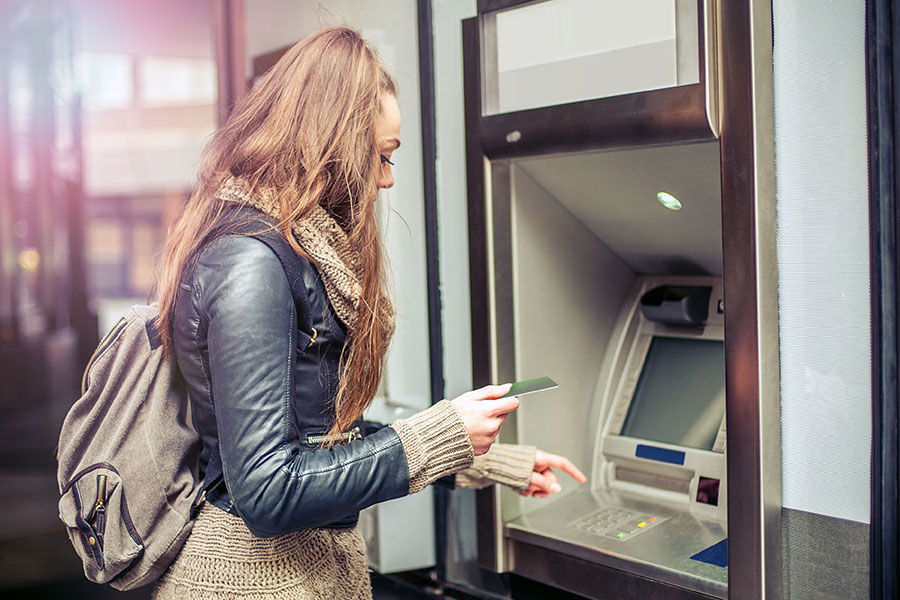Throughout history, humans have sought methods to safely store their most valued possessions. From ancient emperors safeguarding their precious gems to merchants in medieval times locking away their gold coins, the desire to protect assets is as old as civilization itself.

In today’s world, with a blend of both tangible treasures like jewelry and intangible assets like important documents, the need for secure storage remains just as relevant. As we progress into the digital age, bank accounts can now be accessed with a thumbprint. Transactions are completed in mere seconds. In the midst of this digital revolution, the safe deposit box remains a cornerstone of physical asset protection.
Key Takeaways
- Safe deposit boxes are secure, locked containers within a bank vault, providing high-level protection for valuable items and documents with a dual-key access system.
- While offering enhanced security, disaster protection, and privacy, these boxes aren’t federally insured, so separate insurance may be needed for valuable items.
- Access is restricted to bank operating hours, and it’s important to inform a trusted person about the box’s location, key access, and contents for emergencies.
What is a safe deposit box?
A safe deposit box, sometimes referred to as a safety deposit box, is a secure, locked container held within a larger vault, typically in a federally insured bank or credit union. The primary function of these boxes is to offer a private and guarded space for individuals to store valuable items and important documents.
Given their placement within a bank vault, they are designed to withstand natural disasters, theft, and unauthorized access. Most safe deposit boxes operate on a dual-key system. The bank holds one key (known as the guard key), while the box renter holds the other (the personal key). Both keys are needed simultaneously to open the box, ensuring a high level of security.
Historical Background
The origins of the safe deposit box stretch back to ancient civilizations. In those days, people sought safe havens to keep their precious commodities, like gold, silver, and invaluable scripts, away from prying eyes and potential thieves. Temples, for instance, were commonly used as safe storage spots given their revered status.
However, the contemporary concept of the safe deposit box, as we understand and use it today, emerged in 19th-century London. As urban centers expanded and the middle class grew, there was a burgeoning need for a safe, private space to protect personal valuables. The idea of a secure, rentable box within a bank’s fortified vault addressed this need perfectly.
The trend quickly crossed the Atlantic. With the rapid expansion of the U.S. banking industry in the late 19th and early 20th centuries, financial institutions saw the value in offering safe deposit boxes. They recognized not just the practicality for their customers but also the trust it instilled. Over time, what started as a luxury service in major cities became a staple, available at banks and credit unions across the country.
Key Features of a Safe Deposit Box
At its core, a safe deposit box is a private storage space within the larger confines of a bank or credit union’s main vault. Here are the fundamental features:
- Material & construction: The box is usually a metal box, designed to be both fireproof and tamper-resistant. Its sturdy construction ensures that the contents remain safe from external threats.
- Size variety: While the typical image might be of a standard-sized box, in reality, these boxes come in various sizes. From small boxes just big enough for a stack of documents to larger ones that can store art pieces, there’s typically a size to suit every need.
- Dual-key system: One of the defining features of safe deposit boxes is their dual-key access system. The box renter holds one key, often referred to as the personal key. The bank or credit union retains the other, known as the guard key. For a box to be opened, both keys must be used simultaneously. This ensures that neither the bank can access the box without the owner’s consent, nor can the box be accessed if the owner’s key is stolen.
- Security measures: Beyond the dual-key system, safe deposit boxes benefit from being housed in a bank’s primary vault. This means they’re protected by all the security measures a financial institution employs, from surveillance cameras to biometric access controls for the bank vault itself.
Primary Uses of Safe Deposit Boxes
Safe deposit boxes serve as a fortress for the items we hold dear. Given their robust construction and enhanced security measures, these boxes offer advantages over home storage, especially for items of sentimental, monetary, or functional value. Here are their primary uses:
1. Important Documents
The loss of critical paperwork can lead to significant inconveniences, and in some cases, financial or legal complications. Safe deposit boxes ensure:
- Titles & deeds: Safeguarding proof of ownership, be it for land, property, or vehicles.
- Birth certificates & passports: Vital for identity verification and international travel.
- Military discharge papers: Important for veterans seeking benefits or employment opportunities.
- Wills & trust documents: Ensuring they’re safe and easily accessible to execute the deceased’s wishes accurately.
- Other vital records: From marriage certificates to business agreements, all documents that are tough to replace find sanctuary here.
2. Valuables
For many, certain items hold immeasurable sentimental value, while for others, it’s about monetary worth:
- Jewelry: Engagement rings, ancestral jewelry, or high-value watches.
- Collectibles: Coins, stamps, or any other items that might appreciate over time.
- Family heirlooms: Items passed down through generations, carrying family history and memories.
3. Digital Data
Keeping digital information secure is just as important as protecting physical assets in the digital age:
- USB drives & external hard drives: From personal photos and videos to critical business data backups, these devices contain vast amounts of information.
- Cryptocurrency wallets: Physical wallets that store digital currency keys or codes.
Benefits of Using a Safe Deposit Box
Enhanced Security
A safe deposit box isn’t just a storage unit—it’s a fortress. Unlike a checking or savings account that secures digital assets, these boxes protect tangible assets from theft or misplacement. These boxes, nestled in bank vaults, come with layers of security measures, from surveillance systems to patrolling guards.
Protection from Disasters
Natural disasters don’t discriminate, and while our homes are built for comfort, bank vaults are constructed to endure. Be it fires, floods, earthquakes, or tornadoes, items in a safe deposit box remain unscathed. This level of protection is a peace of mind that often surpasses home safes or storage units, which may not provide the same resilience against unforeseen calamities.
Privacy and Confidentiality
In a world where data breaches and privacy concerns are rampant, a safe deposit box remains an oasis of confidentiality. The contents are known only to the box holder, and banks ensure this privacy is upheld.
Even bank personnel don’t have knowledge of what’s inside. This discretion extends to ensuring only those granted explicit access by the box holder (like family members or legal representatives) can access the contents.
Limitations and Considerations
While the benefits of a safe deposit box are numerous, it’s essential to understand some of the limitations and factors to consider:
Unsuitable Items
- Cash: Storing large sums of money in a safe deposit box might seem like a wise decision. However, unlike funds in savings accounts or money market accounts, the money inside the box isn’t federally insured. This means that if the bank suffers a calamity, those funds could be lost. For enhanced security and potential interest, it’s advisable to keep liquid assets in a bank or credit union account that’s federally insured.
- Hazardous materials: It goes without saying, but items that might be harmful or illegal should never be stored in a safe deposit box.
Access Limitations
- Operating hours: One can’t just access their box anytime. It’s restricted to the operating hours of the bank. This can be limiting in emergencies.
- Posthumous access: In the unfortunate event an individual with a safety deposit box passes away, there are often strict regulations dictating who can access the box and when. This might require legal paperwork and a waiting period.
Costs
- Rental fees: Just like renting a space or property, there’s a recurring fee associated with the safe deposit box. This cost can vary based on the box’s size and the financial institution’s policies.
- Key replacement: Misplacing the personal key can result in additional charges. Often, this requires the bank to drill open the box, which can be an expensive procedure.
How to Rent a Safe Deposit Box
Thinking about renting a safe deposit box? Follow these steps to get started:
1. Choose a Bank or Credit Union
Start with familiar ground. If you already have a savings or checking account with a financial institution, it might be prudent to approach them first. They often offer discounts or preferential rates to existing account holders.
2. Provide Identification
Ensure you have the necessary identification. This usually includes government-issued photo ID, and some institutions might require additional documentation or proof of address.
3. Select the Right Size
Safe deposit boxes come in an array of sizes. Think about what you plan to store, both now and in the future, and select a size that accommodates those needs. Remember, it might be more cost-effective to rent a slightly larger box initially than to upgrade later.
4. Understand the Lease Agreement
Like any contract, ensure you’re well-acquainted with the lease agreement’s terms and conditions. This includes understanding the rental fee, access limitations, and procedures in the event of losing a key or other emergencies. Some institutions might offer discounts or incentives for their existing deposit account holders, so always inquire about any promotions or offers.
Alternatives to Safe Deposit Boxes
While safe deposit boxes are popular choices for safeguarding valuables, they’re not the only option available. Here’s a look at some alternatives and their respective pros and cons:
Home Safes
Pros:
- Convenience: Easily accessible anytime, without the need to travel to a bank.
- One-time cost: After the initial investment, there’s no recurring fee.
Cons:
- Vulnerability: Might be susceptible to theft if not adequately secured or hidden.
- Limited disaster protection: While some home safes are fireproof, they may not withstand severe natural disasters as effectively as bank vaults.
Digital Cloud Storage
Pros
- Remote access: Documents can be accessed from anywhere with an internet connection.
- Easy sharing: Can share files or folders with others effortlessly.
Cons
- Security concerns: Cyberattacks or data breaches can compromise digital data.
- Subscription fees: Some premium cloud storage solutions come with monthly or annual costs.
Vault Storage Services
Pros:
- Specialization: These services often cater to specific needs, such as art storage or precious metal storage.
- Flexible access: Some offer 24/7 access, surpassing traditional bank hours.
Cons:
- Cost: Can be pricier than traditional bank safe deposit boxes.
- Location: There might be fewer facilities available, requiring a longer travel distance.
Tips for Organizing and Managing Your Safe Deposit Box
Having a safe deposit box is one thing, but efficiently managing it is another. Here are some tips to ensure smooth operation:
Maintain an Inventory
Keep a detailed list of what’s inside your safe deposit box. This not only helps you keep track but can be invaluable for insurance purposes or if someone else needs to access the box. Store a copy of this list in a secure location at home, and consider taking photos of valuable items.
Regular Updates
Don’t treat your box as a ‘set it and forget it’ storage solution. Periodically review its contents. As with managing direct deposit details or monitoring high yield savings accounts for interest rates, ensure you’re abreast with what’s inside your box. Rotate out outdated documents and replace them with current ones.
Informed Trust
While the contents of your box are private, make sure that at least one trusted person—be it a family member or legal advisor—knows of its existence. They should be aware of the key’s location, access procedures, and the box’s primary contents. This becomes essential in emergencies or unexpected events.
Common Misconceptions about Safe Deposit Boxes
Like many banking services, safe deposit boxes come with their fair share of myths and misunderstandings. Let’s debunk some of the most prevalent misconceptions:
Myth 1: Banks Can Access Your Box Anytime
Truth: A prevalent misunderstanding is that banks have unfettered access to safe deposit boxes. However, the dual-key system in place ensures that your privacy is maintained.
While the bank has a “guard key,” your box cannot be opened without the conjunction of your personal key. It ensures a heightened level of security and privacy for the contents of your box.
Myth 2: Everything Inside Is Insured
Truth: One might assume that just as funds in bank accounts are federally insured, the same would apply to the contents of a safe deposit box. But this is not the case. The contents of your box aren’t covered by the bank’s FDIC insurance.
If you’re storing valuable items like jewelry, art, or important documents, you’d need to get separate insurance coverage, often as an addition to a homeowner’s or renter’s insurance policy.
Myth 3: Forgotten Boxes Become Bank Property
Truth: If a box remains unclaimed or rental fees go unpaid for an extended period, the bank doesn’t simply claim the box and its contents. Financial institutions usually make several attempts to contact the box owner.
If these attempts are unsuccessful, the contents might be turned over to the state’s unclaimed property offices. The exact time frame and process can vary by state, but it ensures that items are held in trust for potential future claims by the rightful owner or their heirs.
Conclusion
In an age where digital banking reigns supreme and where savings and deposit accounts can be managed with a click, there’s still an undeniable value in the traditional safe deposit box. They offer an unparalleled level of security for those irreplaceable items and important documents, nestled safely away in metal box sanctuaries within bank vaults.
Whether it’s treasured jewelry, essential medical directives, or simply peace of mind, understanding the workings and benefits of a safe deposit box can be an invaluable asset in anyone’s personal finance toolkit.
Frequently Asked Questions
How frequently can I access my safe deposit box?
Access is typically limited to the operating hours of the bank. Some banks may have extended hours, while others might be limited to standard business hours.
What happens if I lose my key to my safe deposit box?
If you lose your key, the bank can still open the box for you, but there will likely be a fee associated with drilling the lock and replacing it.
Can I share access to my safe deposit box with a family member or friend?
Yes, most banks allow you to have co-renters or give authorized access to specific individuals. Each person would typically need to sign the lease agreement and provide identification.
What happens to items in a safe deposit box if the owner dies?
When the owner of a safe deposit box dies, the contents of the box aren’t immediately accessible to family or executors. The bank must be notified of the death and provided with a copy of the death certificate. The process that follows can vary based on state laws and the bank’s policies. Typically:
- If there’s a co-renter or a named successor on the box, they might gain immediate access.
- If not, an executor or legal representative of the deceased will need to provide proof of their authority, often in the form of a court order or letters testamentary, to access the box.
- There may be an inventory process where the bank, in the presence of the executor or an appointed person, lists the box’s contents for probate purposes.
It’s essential to check with the specific bank or credit union and local laws to understand the precise steps in your jurisdiction.
What happens if a safe deposit box is abandoned?
When a safe deposit box is deemed abandoned, usually due to unpaid fees or extended lack of communication, the bank will first try to contact the renter. If unsuccessful, they’ll send a delinquency notice.
After a certain period, the bank may drill the box and inventory its contents. If the owner doesn’t claim these contents, they are handed over to the state’s unclaimed property office. The state holds these items and allows the owner or their heirs to claim them by providing proof of ownership.



